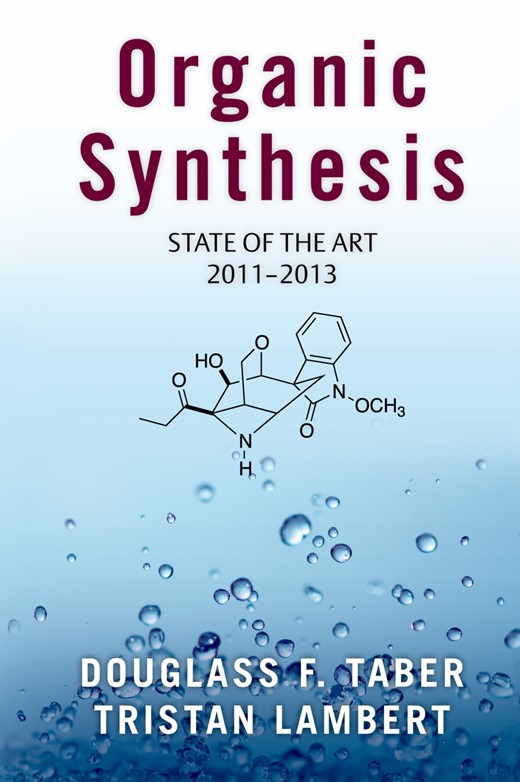 Organic Synthesis: State of the Art 2011-2013
Organic Synthesis: State of the Art 2011-2013
Contents
6633 Enantioselective Synthesis of Alcohols and Amines: The Fujii/Ohno Synthesis of (+)-Lysergic Acid
Get access-
Published:January 2015
Cite
Abstract
Ramón Gómez Arrayás and Juan C. Carretero of the Universidad Autónoma de Madrid effected (Chem. Commun. 2011, 47, 6701) enantioselective conjugate borylation of an unsaturated sulfone 1, leading to the alcohol 2. Robert E. Gawley of the University of Arkansas found (J. Am. Chem. Soc. 2011, 133, 19680) conditions for enantioselective ketone reduction that were selective enough to distinguish between the ethyl and propyl groups of 3 to give 4. Vicente Gotor of the Universidad de Oviedo used (Angew. Chem. Int. Ed. 2011, 50, 8387) an overexpressed Baeyer-Villiger monoxygenase to prepare 6 by dynamic kinetic resolution of 5. Li Deng of Brandeis University prepared (J. Am. Chem. Soc. 2011, 133, 12458) 8 in high ee by kinetic enantioselective migration of the alkene of racemic 7. Bernhard Breit of the Freiburg Institute for Advanced Studies established (J. Am. Chem. Soc. 2011, 133, 20746) the oxygenated quaternary center of 10 by the addition of benzoic acid to the allene 9. Keith R. Fandrick of Boehringer Ingelheim constructed (J. Am. Chem. Soc. 2011, 133, 10332) the oxygenated quaternary center of 13 by enantioselective addition of the propargylic nucleophile 12 to 11. Yian Shi of Colorado State University devised (J. Am. Chem. Soc. 2011, 133, 12914) conditions for the enantioselective transamination of the α-keto ester 14 to the amine 15. Professor Deng added (Adv. Synth. Catal. 2011, 353, 3123) 18 to an enone 17 to give the protected amine 19. Song Ye of the Institute of Chemistry, Beijing effected (J. Am. Chem. Soc. 2011, 133, 15894) elimination/addition of an unsaturated acid chloride 20 to give the γ-amino acid derivative 22. Frank Glorius of the Universität Münster added (Angew. Chem. Int. Ed. 2011, 50, 1410) an aldehyde 23 to 24 to give the amide 25. Sentaro Okamoto of Kanagawa University designed (J. Org. Chem. 2011, 76, 6678) an organocatalyst for the enantioselective Steglich rearrangement of 26, creating the aminated quaternary center of 27. Most impressive of all was the report (Org. Lett. 2011, 13, 5460) by Hélène Lebel of the Université de Montréal of the direct enantioselective C–H amination of 28 to give 29.
Sign in
Personal account
- Sign in with email/username & password
- Get email alerts
- Save searches
- Purchase content
- Activate your purchase/trial code
- Add your ORCID iD
Purchase
Our books are available by subscription or purchase to libraries and institutions.
Purchasing information| Month: | Total Views: |
|---|---|
| October 2022 | 3 |
| December 2022 | 3 |
| January 2023 | 2 |
| February 2023 | 4 |
| March 2023 | 8 |
| April 2023 | 1 |
| May 2023 | 1 |
| June 2023 | 2 |
| July 2023 | 4 |
| August 2023 | 2 |
| September 2023 | 2 |
| October 2023 | 2 |
| November 2023 | 2 |
| December 2023 | 2 |
| January 2024 | 1 |
| February 2024 | 1 |
| March 2024 | 5 |
| April 2024 | 5 |
| May 2024 | 4 |
| June 2024 | 2 |
| July 2024 | 1 |
| August 2024 | 1 |
Get help with access
Institutional access
Access to content on Oxford Academic is often provided through institutional subscriptions and purchases. If you are a member of an institution with an active account, you may be able to access content in one of the following ways:
IP based access
Typically, access is provided across an institutional network to a range of IP addresses. This authentication occurs automatically, and it is not possible to sign out of an IP authenticated account.
Sign in through your institution
Choose this option to get remote access when outside your institution. Shibboleth/Open Athens technology is used to provide single sign-on between your institution’s website and Oxford Academic.
If your institution is not listed or you cannot sign in to your institution’s website, please contact your librarian or administrator.
Sign in with a library card
Enter your library card number to sign in. If you cannot sign in, please contact your librarian.
Society Members
Society member access to a journal is achieved in one of the following ways:
Sign in through society site
Many societies offer single sign-on between the society website and Oxford Academic. If you see ‘Sign in through society site’ in the sign in pane within a journal:
If you do not have a society account or have forgotten your username or password, please contact your society.
Sign in using a personal account
Some societies use Oxford Academic personal accounts to provide access to their members. See below.
Personal account
A personal account can be used to get email alerts, save searches, purchase content, and activate subscriptions.
Some societies use Oxford Academic personal accounts to provide access to their members.
Viewing your signed in accounts
Click the account icon in the top right to:
Signed in but can't access content
Oxford Academic is home to a wide variety of products. The institutional subscription may not cover the content that you are trying to access. If you believe you should have access to that content, please contact your librarian.
Institutional account management
For librarians and administrators, your personal account also provides access to institutional account management. Here you will find options to view and activate subscriptions, manage institutional settings and access options, access usage statistics, and more.